| "A sky bison is a companion for life." |
| — Sister Iio to the Air Nomad children.[1] |
The flying bison, also known as sky bison and air bison, lived in the air temples along with the Air Nomads.[2] The most notable flying bison was Appa, Avatar Aang's animal guide and Team Avatar's primary means of long-distance transportation.[3] Some bison also live in the Fire Nation, tended to on an island by the Bhanti Tribe.[4]
History
Prior to the Hundred Year War, many flying bison lived in the air temples. They were highly respected by the Air Nomads, who regarded them as the first airbenders. While airbenders were in training, they each received a flying bison to become their lifelong companion. The sky bison was believed to be the only way in which people could reach an air temple.
After the Air Nomad Genocide, Appa was believed to be the last of the flying bison. However, during his adventures after the Hundred Year War, Aang discovered a new herd, and the population started to grow again with colonies of healthy bison residing at all of the air temples.
When Ikki ran away while visiting the Southern Air Temple in 171 AG, she hid in a cave that a bison family had made their home. While both parents were out, the young airbender entertained the four calves whom she had named Blueberry Spicehead, Princess Rainbow, Twinkle Starchild, and Juniper Lightning Bug. When Tenzin eventually found his daughter, he joined her in the cave, bonding particularly with Blueberry Spicehead.[5]
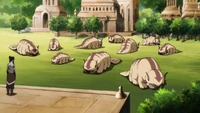
The Bhanti Tribe raised a herd of flying bison in the years after the Hundred Year War.
After Korra reconnected with her Avatar Spirit, she was given a flying bison from a herd that an elderly female shaman and other members of the Bhanti Tribe had been raising since the end of the Hundred Year War. The Avatar used the bison to travel to the Eastern Air Temple in preparation for the upcoming Harmonic Convergence.[4]
A few weeks after Harmonic Convergence, poachers near the Northern Air Temple began to capture week-old baby bison to sell for food to the upper class in Ba Sing Se, but were thwarted by Tenzin, new airbenders, and adult bison.[6]
When the Red Lotus ambushed the Air Nation at the Northern Air Temple, the airbenders attempted to evacuate using the flying bison at the stable. Before they could reach them, however, a nearby explosion, caused by P'Li's combustionbending, spooked the animals and they took off without the humans. Later that evening, a bison calf licked Kai while the young airbender was suspended upside down on a tree after being shot unconscious by P'Li. As he came to, the baby bison lowered himself, allowing Kai to descend upon his back. Earning a stroke on his head, the bison flew them out of there.[7]
When the Triple Threat Triad attacked the spirit portal a flying bison escorted Team Avatar and Jinora's astral projection from Air Temple Island to Republic city to help defend the portal from the triads attacking it.[8]
Anatomy
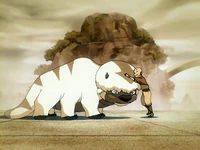
Although an adult bison can easily carry five people, a bison calf is not much bigger than a child.
Flying bison have five stomachs,[9] flat manatee-like tails, brown eyes, shaggy white fur, and a brown arrow that runs along their back from tail-tip to forehead. They have four transversal stripes running over their back and tail, which ends in a brown tip. They have six legs with three toes on each foot. As they are primarily herbivores, flying bison have flat teeth shaped like peanuts, which are spread out on the roof and bottom of the mouth in groups of ten.[10] A fully-grown flying bison can easily weigh ten tons.[11][12] The tail is dexterous enough to touch the middle of their back, even with quite a bit of force if necessary.[13]
The species Aang rediscovered after the Hundred Year War has a slightly different fur pattern with multiple brown stripes running down their backs, which does not end in a brown tip, and brown ears instead of white.[14]
Behavior
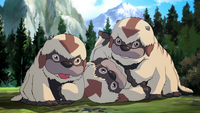
Flying bison calves are unable to fly for a week or two after birth.
All flying bison employ airbending to fly, using their wide tails to steer through air currents and to defend themselves from attacks. They are also able to use their mouths to airbend.[1] Since young flying bison are incapable of flight for a week or two after they are born, the herd will stay close to the ground to protect them.[6] Though fairly docile, flying bison can be fierce and powerful opponents if pressed or enraged, possessing great physical strength and airbending skills, as Appa demonstrated on several occasions. Parents are also protective of their young, flightless offspring and will attack anyone who gets near them. If the person is on good terms with the bison, however, they are allowed to get close to the calves.[6] They also possess a good memory, as Appa was shown to find his way back to the site of Wan Shi Tong's library after the building had disappeared into the Spirit World, leaving nothing but an unremarkable crater in the middle of a mostly featureless desert.[15]
These creatures were the main means of transportation for Air Nomads. It was customary for young Air Nomads to choose a flying bison to be their lifelong companion. Aang chose Appa at the Eastern Air Temple when he was a young child by giving him an apple.[1] This tradition changed following the emergence of the Air Nation, when the bison themselves chose their own lifelong companions.[16]
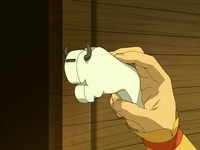
A bison whistle can be used to summon a flying bison.
At the Northern Air Temple, airbenders held championships for bison polo.[17] This game was played in the air; as airbenders rode their bison, they tried to force the ball with their polo mallet into an opponent's goal. Airbenders use the command "yip-yip" to prompt their bison to take flight, with the association between the verbal cue and the action becoming apparent even prior to formal training of calves.[7] To summon a bison from a distant location, it is possible to use a bison whistle, which emits a sound at a frequency inaudible to humans but clearly detectable for bison.[18] It takes years for an individual to truly tame and train a bison.[6]
Notable flying bison
Connection
The flying bison is a hybrid between a bison and a manatee. The real-life bison shares a similar history to the flying bison, in that they were a very abundant species until foreigners came and hunted them down, reducing their numbers to near-extinction. Both have also been commonly misidentified as a buffalo.
Like bats and most birds (aside from megapodes), sky bison are flightless and defenseless in the first weeks of life.
Trivia
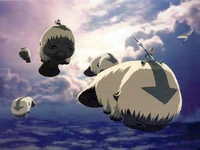
An early design of the flying bison bears a resemblance to the sea manatee.
- The circus master called Appa a "Wind Buffalo" for his circus act.[1]
- Flying bison use flight to graze from the top of trees.[19]
- The flying bison are revered by the Air Nomads for inspiring the art of airbending; the tattoos of an airbending master deliberately imitate the arrow-shaped markings of the bison.
- The movement animation of the flying bison was heavily influenced by the similarly-shaped multi-legged Catbus in Hayao Miyazaki's movie My Neighbor Totoro. The series' creators have professed their love of Miyazaki's work in many interviews.
- Original designs of flying bison made them more closely resemble sea manatees.[20]
- Flying bison are the world's loudest snorers, with airbenders being second.[21]
- In Avatar Korra's time, the new breed of sky bison that reside on Air Temple Island live in a series of caves. However, Aang's sky bison, Appa, had a fear of going in caves, meaning that Appa's phobia was a personal trait rather than a behavioral trait of the species.[22]
- Both flying bison and dragons have shown affection by licking people.[23][24]
- Flying bison meat is a rare delicacy enjoyed primarily by nobles living in the upper echelon of Ba Sing Se.[6] This is considered to be "disgusting" by Air Nomads like Jinora, whose culture venerates the flying bison.